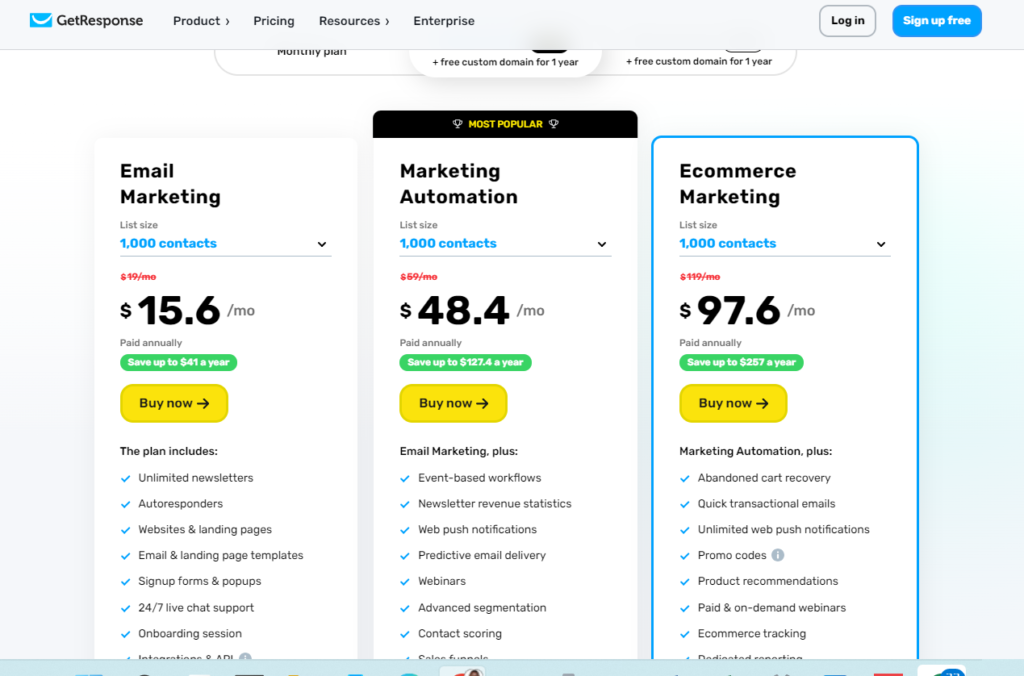When it comes to choosing the best email marketing tool for your business, the debate often comes down to GetResponse vs ConvertKit. Both platforms offer powerful features to enhance your email marketing strategy, but they cater to different needs and preferences. In this blog post, we’ll dive into a detailed comparison of GetResponse and ConvertKit, exploring their features, ease of use, pricing, and more. By the end, you’ll have a clear understanding of which platform is better suited for your specific marketing goals and requireme
Features and Functionality
When evaluating GetResponse vs ConvertKit, understanding their features and functionality is crucial for selecting the right email marketing platform for your needs. Both platforms offer robust tools, but they cater to different types of users and business requirements. Here’s a detailed comparison of their key features and functionality.
GetResponse Features and Functionality
click here for your getresponse
GetResponse provides a comprehensive suite of tools designed for a wide range of email marketing needs:
- Email Marketing Tools: GetResponse offers a powerful email editor with drag-and-drop functionality, allowing users to create visually appealing emails without needing coding skills. It includes a variety of customizable templates, automation triggers, and segmentation options to target specific audiences effectively.
- Automation and Workflows: The platform excels in automation with its advanced workflows. Users can design complex automation sequences using a visual workflow builder, which includes options for setting up autoresponders, email sequences, and conditional logic based on user behavior.
- Landing Pages and Forms: GetResponse includes a landing page builder and form creator, which are useful for generating leads and driving conversions. It provides a range of templates and customization options to create high-converting landing pages and opt-in forms.
- E-commerce Integrations: For e-commerce businesses, GetResponse integrates with popular platforms like Shopify and WooCommerce, offering features like product recommendations and abandoned cart emails.
- CRM and Contact Management: GetResponse includes built-in CRM capabilities, allowing users to manage contacts, track interactions, and segment audiences based on various criteria.
ConvertKit Features and Functionality
ConvertKit is tailored towards creators and bloggers, focusing on simplicity and effective email marketing:
- Email Marketing Tools: ConvertKit offers a user-friendly email editor with basic customization options. It emphasizes simplicity, making it easy to create and send newsletters, broadcasts, and automated sequences.
- Automation and Workflows: ConvertKit’s automation tools are designed with creators in mind, featuring visual automation workflows that are easy to set up. Users can create automated email sequences based on subscriber actions and interests.
- Landing Pages and Forms: ConvertKit provides tools for building landing pages and sign-up forms, optimized for lead generation. The platform includes several templates and customization options to match your branding and campaign goals.
- E-commerce Integrations: While ConvertKit has fewer e-commerce integrations compared to GetResponse, it supports integrations with platforms like Shopify and PayPal, focusing on essential features for online creators.
- CRM and Contact Management: ConvertKit’s CRM features are streamlined, with straightforward options for tagging and segmenting subscribers. It’s designed to help creators manage their audience efficiently without overwhelming complexity.
Ease of Use
When comparing GetResponse vs ConvertKit, one of the most important factors to consider is ease of use. Both platforms aim to streamline email marketing processes, but they do so in different ways. Here’s a closer look at how each platform handles usability.
GetResponse Ease of Use
GetResponse is designed to cater to a wide range of users, from beginners to advanced marketers. Its interface is feature-rich but straightforward:
- User Interface: GetResponse offers a clean and intuitive dashboard that provides easy access to its various tools. The drag-and-drop editor for creating emails and landing pages is user-friendly, making it simple for users to design attractive content without needing technical skills.
- Learning Curve: Although GetResponse has a broad range of features, it generally maintains a moderate learning curve. New users may need some time to explore and master its advanced features like automation workflows and CRM. However, the platform provides extensive tutorials and guides to assist with the learning process.
- Customer Support: GetResponse offers several support options, including live chat, email support, and a comprehensive knowledge base. This ensures that users can quickly get help when needed and effectively navigate the platform’s features.
ConvertKit Ease of Use
ConvertKit is tailored towards creators and bloggers who seek simplicity and efficiency. Here’s how it performs in terms of ease of use:
- User Interface: ConvertKit features a minimalist and clean interface that emphasizes ease of navigation. Its email editor and automation tools are designed to be straightforward, allowing users to set up campaigns and workflows quickly without a steep learning curve.
- Learning Curve: ConvertKit is known for its simplicity and ease of use. The platform’s streamlined features mean that even beginners can quickly grasp the basics of email marketing and automation. It focuses on essential tools that cater to the needs of content creators and small businesses.
- Customer Support: ConvertKit provides various support channels, including email support and a knowledge base with helpful articles and tutorials. Its user-friendly design reduces the need for extensive support, but resources are readily available for those who need additional help.
Pricing and Plans
When choosing between GetResponse vs ConvertKit, understanding the pricing and plans offered by each platform is essential. Both services offer different tiers and features that cater to various business needs and budgets. Here’s a breakdown of their pricing structures and what you get with each plan.
GetResponse Pricing and Plans
GetResponse provides a range of pricing options designed to suit different business sizes and requirements. Their plans include:
- Basic Plan: This entry-level plan includes essential features such as email marketing, autoresponders, and a basic landing page builder. It is suitable for small businesses or individuals starting with email marketing. Pricing starts at approximately $15 per month for up to 1,000 subscribers.
- Plus Plan: The Plus Plan includes all the features of the Basic Plan, plus additional tools like automation workflows, webinar hosting, and advanced segmentation. It is ideal for growing businesses that need more functionality. Pricing starts at around $49 per month for up to 1,000 subscribers.
- Professional Plan: This plan offers advanced features such as CRM tools, unlimited automation, and advanced reporting. It is designed for larger businesses with more complex needs. Pricing starts at about $99 per month for up to 1,000 subscribers.
- Max Plan: For enterprises needing custom solutions, the Max Plan provides personalized support and additional features. Pricing is customized based on specific requirements.
ConvertKit Pricing and Plans
ConvertKit offers a more straightforward pricing structure focused on simplicity and ease of use:
- Free Plan: ConvertKit provides a free plan with basic email marketing features for up to 300 subscribers. This plan includes unlimited email sends, sign-up forms, and basic automation, making it a good option for beginners or small creators.
- Creator Plan: The Creator Plan includes additional features such as advanced automation, email sequences, and premium support. It starts at around $15 per month for up to 1,000 subscribers. This plan is suitable for growing creators who need more advanced tools.
- Creator Pro Plan: This higher-tier plan offers even more features, including advanced reporting, additional integrations, and priority support. Pricing starts at approximately $29 per month for up to 1,000 subscribers. It is designed for serious creators and small businesses that require comprehensive features and enhanced support.


Deliverability and Performance
When choosing between GetResponse vs ConvertKit, deliverability and performance are crucial factors that can impact the success of your email marketing campaigns. Both platforms aim to ensure your emails reach your audience effectively, but they handle deliverability and performance in different ways. Here’s a detailed comparison of how each platform performs in these areas.
GetResponse Deliverability and Performance
GetResponse is known for its robust email deliverability and performance features:
- Deliverability Rates: GetResponse maintains a strong reputation for high deliverability rates, thanks to its adherence to best practices in email marketing. The platform uses dedicated IP addresses, sender authentication (DKIM, SPF), and anti-spam measures to ensure your emails land in the inbox rather than the spam folder.
- Performance Tracking: GetResponse offers comprehensive analytics and reporting tools that track email performance. Users can monitor open rates, click-through rates, bounce rates, and unsubscribe rates. These insights help optimize future campaigns and improve engagement.
- A/B Testing: The platform includes A/B testing features that allow users to test different email subject lines, content, and designs. This helps determine what resonates best with your audience and enhances overall campaign performance.
ConvertKit Deliverability and Performance
ConvertKit also focuses on high deliverability and efficient performance:
- Deliverability Rates: ConvertKit is praised for its solid deliverability rates, which are supported by its focus on maintaining a clean and engaged subscriber list. The platform offers built-in spam checkers and best practice guidelines to help ensure your emails reach the inbox.
- Performance Tracking: ConvertKit provides essential performance metrics such as open rates, click rates, and subscriber growth. While it may not be as feature-rich as GetResponse in this area, it offers enough data to make informed decisions and optimize campaigns.
- A/B Testing: ConvertKit supports A/B testing, but it is more limited compared to GetResponse. Users can test email subject lines and send times, but the platform doesn’t offer as many testing options for content and design.
Integrations
When comparing GetResponse vs ConvertKit, understanding their integration capabilities is crucial for seamless operation with other tools and platforms. Both platforms offer integrations to enhance their functionality, but they differ in scope and available connections. Here’s a detailed look at the integration options each platform provides.
GetResponse Integrations
GetResponse offers a broad range of integrations designed to connect with various tools and platforms:
- E-commerce Platforms: GetResponse integrates with major e-commerce solutions such as Shopify, WooCommerce, and Magento. These integrations allow users to sync customer data, automate abandoned cart emails, and track sales performance.
- CRM and Marketing Tools: The platform connects with popular CRM systems like Salesforce and HubSpot, as well as marketing tools such as Google Analytics. This helps streamline data management and enhances your marketing efforts.
- Social Media: GetResponse supports integration with social media platforms including Facebook and Instagram. Users can create and manage Facebook ads directly from the GetResponse dashboard.
- Zapier Integration: For more flexibility, GetResponse integrates with Zapier, enabling connections with over 2,000 apps. This allows users to automate workflows and sync data across different tools and platforms.
ConvertKit Integrations
ConvertKit focuses on essential integrations that cater primarily to creators and small businesses:
- E-commerce Platforms: ConvertKit integrates with e-commerce platforms such as Shopify and PayPal, helping users manage transactions and automate email communications related to sales and customer engagement.
- CRM and Marketing Tools: While ConvertKit does not have as extensive CRM integrations as GetResponse, it offers connections with tools like Google Sheets and Facebook Ads. These integrations help with managing subscriber data and running targeted ad campaigns.
- Social Media: ConvertKit’s social media integrations are more limited compared to GetResponse. It supports basic connections with platforms like Facebook for ad management but does not offer extensive social media tools.
- Zapier Integration: Similar to GetResponse, ConvertKit integrates with Zapier, providing access to thousands of apps for enhanced automation and workflow management.
Where to Add Images
- Integration Comparison Table: Create a side-by-side table listing the key integrations available for GetResponse and ConvertKit. Include columns for categories such as e-commerce platforms, CRM tools, and social media.
- Integration Screenshots: Include screenshots of the integration setup pages or dashboards for both platforms. This helps readers visualize how integrations are configured and managed.
- Zapier Workflow Examples: Add images or diagrams showing example workflows set up through Zapier for both GetResponse and ConvertKit. This demonstrates how users can automate tasks and connect different apps.
Customization and Design
When evaluating GetResponse vs ConvertKit, customization and design capabilities play a crucial role in shaping the effectiveness of your email marketing campaigns. Both platforms offer various options for creating and personalizing content, but they differ in their approach and features. Here’s a detailed comparison of how each platform handles customization and design.
GetResponse Customization and Designs
GetResponse provides extensive customization options to create visually appealing and branded content:
- Email Templates: GetResponse offers a wide variety of professionally designed email templates that users can customize. The drag-and-drop editor allows for easy modifications, including changes to colors, fonts, and images, enabling users to match their emails with their brand identity.
- Landing Pages: The platform includes a landing page builder with numerous templates that can be tailored to specific campaigns. Users can customize layouts, add elements, and adjust design features to create high-converting landing pages that align with their marketing goals.
- Forms and Pop-ups: GetResponse allows users to design opt-in forms and pop-ups that can be customized to fit the style of their website. The platform provides various templates and design tools to ensure that forms and pop-ups are both functional and visually appealing.
- A/B Testing: GetResponse supports A/B testing for emails, allowing users to test different designs and content variations to determine what performs best with their audience. This helps in refining email designs for optimal engagement.
ConvertKit Customization and Designs
ConvertKit offers a streamlined approach to customization and design, focusing on simplicity and ease of use:
- Email Templates: ConvertKit provides a selection of clean, minimalist email templates. While the customization options are more limited compared to GetResponse, users can still adjust basic elements such as text, images, and colors to create professional-looking emails.
- Landing Pages: ConvertKit includes a landing page builder with several customizable templates. The design options are straightforward, allowing users to quickly create and modify landing pages without extensive design skills.
- Forms and Pop-ups: The platform offers basic design options for opt-in forms and pop-ups. ConvertKit’s form builder is user-friendly and enables essential customization to fit your brand’s style, though it may not have as many advanced design features as GetResponse.
- A/B Testing: ConvertKit supports A/B testing for email subject lines and send times, but it offers fewer options for testing different design elements compared to GetResponse. This may be a consideration for users who want to experiment with various design aspects.
Automation and Segmentation
When comparing GetResponse vs ConvertKit, automation and segmentation are critical aspects that can significantly enhance the efficiency and effectiveness of your email marketing campaigns. Both platforms offer robust features in these areas but with some differences in capabilities and ease of use. Here’s a closer look at how each platform handles automation and segmentation.
GetResponse Automation and Segmentation
GetResponse provides advanced tools for automation and segmentation, making it suitable for users who need sophisticated marketing workflows:
- Automation Workflows: GetResponse excels in automation with its visual workflow builder. Users can create complex automation sequences that include triggers, actions, and conditions. This allows for highly personalized email sequences based on user behavior, such as website visits, email opens, and purchase history.
- Advanced Segmentation: The platform offers powerful segmentation options, enabling users to create segments based on detailed criteria like engagement level, demographics, and purchase behavior. This helps in targeting specific groups with tailored messages, improving the relevance and effectiveness of campaigns.
- Behavioral Targeting: GetResponse supports behavioral targeting, which lets you send emails based on user interactions. For example, you can automate follow-up emails for users who click on specific links or complete certain actions.
- Lead Scoring: The platform includes lead scoring features that help prioritize leads based on their engagement and behavior. This can be integrated into automation workflows to focus efforts on high-value prospects.
ConvertKit Automation and Segmentation
ConvertKit focuses on simplicity and ease of use in its automation and segmentation features, ideal for creators and small businesses:
- Visual Automation Editor: ConvertKit offers a user-friendly visual automation editor that allows users to create automated email sequences with simple drag-and-drop functionality. While not as feature-rich as GetResponse’s workflow builder, it supports essential automation tasks like welcome sequences and subscriber nurturing.
- Basic Segmentation: ConvertKit provides basic segmentation options through tags and segments. Users can tag subscribers based on their interests and actions, and then create segments for targeted email campaigns. While this is effective for simple segmentation, it may not offer the depth available in GetResponse.
- Automation Rules: ConvertKit includes automation rules that trigger actions based on subscriber behavior, such as sending a specific email when a subscriber performs a particular action. This feature helps in creating responsive and timely email campaigns.
- Subscriber Management: The platform allows for straightforward management of subscribers through tags and segments, making it easy to organize and target different groups.
click here for your getresponse
Customer Support and Resources
When evaluating GetResponse vs ConvertKit, customer support and available resources are crucial factors that can significantly impact your experience with the platform. Both services offer different levels of support and resources to help users navigate their email marketing tools effectively. Here’s a detailed comparison of the customer support and resources provided by each platform.
GetResponse Customer Support and Resources
GetResponse is known for its extensive support options and resources:
- Support Channels: GetResponse offers multiple support channels, including live chat, email support, and phone support. This provides users with various ways to get help, whether they need immediate assistance or prefer detailed responses through email.
- Knowledge Base: The platform has a comprehensive knowledge base with articles, guides, and tutorials covering a wide range of topics. This resource is valuable for users who prefer self-service options to resolve issues or learn about new features.
- Webinars and Training: GetResponse provides webinars and training sessions to help users maximize their use of the platform. These sessions cover various aspects of email marketing and platform features, offering valuable insights and tips.
- Community and Forums: GetResponse has an active user community and forums where users can ask questions, share experiences, and get advice from other marketers. This community can be a helpful resource for troubleshooting and learning best practices.
ConvertKit Customer Support and Resources
ConvertKit offers focused support and resources tailored to its user base:
- Support Channels: ConvertKit provides support through email and live chat. While it does not offer phone support, the available channels are responsive and designed to address user inquiries and issues effectively.
- Knowledge Base: ConvertKit has a well-organized knowledge base with articles, how-to guides, and video tutorials. This resource helps users quickly find answers to common questions and learn how to use the platform’s features.
- Email Courses and Webinars: ConvertKit offers email courses and webinars aimed at helping users improve their email marketing skills. These resources are designed to provide practical tips and strategies for successful email campaigns.
- Community and Forums: ConvertKit has an engaged user community and forum where users can discuss strategies, ask questions, and share insights. This community aspect helps users connect with others who have similar interests and challenges.
Compliance and Security of ConvertKit vs GetResponse
When comparing GetResponse vs ConvertKit, compliance and security are essential considerations to ensure that your email marketing practices are legal, ethical, and secure. Both platforms prioritize these aspects but offer different features and approaches. Here’s a detailed look at how each platform addresses compliance and security.
GetResponse Compliance and Security
GetResponse emphasizes strong compliance and security measures to protect user data and adhere to regulations:
- GDPR Compliance: GetResponse complies with the General Data Protection Regulation (GDPR), ensuring that users in the European Union are protected. The platform provides features such as consent management, data processing agreements, and options for users to manage their data preferences.
- CAN-SPAM Act Compliance: GetResponse adheres to the CAN-SPAM Act regulations, including providing clear unsubscribe options and honoring opt-out requests promptly. This ensures that users comply with U.S. email marketing laws.
- Security Measures: GetResponse implements robust security measures, including data encryption, secure data storage, and regular security audits. The platform uses SSL/TLS protocols to protect data transmitted over the internet and has measures in place to prevent unauthorized access.
- Two-Factor Authentication: For added security, GetResponse offers two-factor authentication (2FA) to protect user accounts from unauthorized access. This extra layer of security helps safeguard your account credentials.
ConvertKit Compliance and Security
ConvertKit also focuses on compliance and security to ensure a safe and legal email marketing environment:
- GDPR Compliance: ConvertKit complies with GDPR requirements, offering tools for consent management, data protection, and GDPR-friendly data processing agreements. Users can manage subscriber consent and data access according to EU regulations.
- CAN-SPAM Act Compliance: ConvertKit ensures compliance with the CAN-SPAM Act by providing features such as unsubscribe links in emails and honoring opt-out requests. This helps users adhere to U.S. email marketing laws.
- Security Measures: ConvertKit employs strong security practices, including data encryption, secure data storage, and regular security updates. The platform uses SSL/TLS to protect data in transit and employs measures to secure user information.
- Two-Factor Authentication: ConvertKit supports two-factor authentication (2FA) to enhance account security. This feature adds an extra layer of protection against unauthorized access.
User Feedback and Reviews for ConvertKit vs GetResponse
When deciding between GetResponse vs ConvertKit, examining user feedback and reviews can provide valuable insights into how each platform performs in real-world scenarios. Reviews from actual users reveal strengths and weaknesses that can help you make an informed decision. Here’s a detailed comparison based on user feedback and reviews for both platforms.
GetResponse User Feedback and Reviews
GetResponse generally receives positive feedback for its comprehensive features and versatility:
- Strengths: Users appreciate GetResponse for its wide range of features, including email marketing, automation, landing page builders, and webinar hosting. Many reviews highlight its robust automation capabilities and the ability to create sophisticated workflows. The platform’s extensive integrations with other tools are also frequently praised.
- Areas for Improvement: Some users report a steeper learning curve due to the platform’s broad feature set. Reviews often mention that while GetResponse offers many functionalities, navigating through all its options can be overwhelming for beginners. Additionally, there are occasional complaints about customer support response times.
- Overall Impression: GetResponse is well-regarded for its all-in-one solution that caters to various marketing needs. Users looking for a comprehensive platform with a wide array of tools and features tend to find it a valuable choice.
ConvertKit User Feedback and Reviews
ConvertKit is often noted for its simplicity and effectiveness, especially among creators and small businesses:
- Strengths: ConvertKit is praised for its user-friendly interface and ease of use. Many users appreciate its focus on essential email marketing features and straightforward automation tools. The platform is frequently highlighted for its excellent customer support and helpful resources.
- Areas for Improvement: Some reviews point out limitations in customization and advanced features compared to other platforms like GetResponse. Users sometimes note that ConvertKit’s feature set is less extensive, which might not meet the needs of those requiring more advanced functionalities.
- Overall Impression: ConvertKit is highly regarded for its simplicity and effectiveness, making it a popular choice for creators and small businesses looking for a straightforward, easy-to-use email marketing tool.
Pros and Cons
When choosing between GetResponse vs ConvertKit, understanding the pros and cons of each platform can help you make an informed decision. Both services offer unique advantages and some limitations, so here’s a straightforward comparison to guide you.
GetResponse Pros and Cons
Pros:
- Comprehensive Features: GetResponse stands out with its extensive feature set, including email marketing, automation workflows, landing page builders, and webinar hosting. This makes it a versatile tool for various marketing needs.
- Advanced Automation: The platform’s visual automation builder allows for the creation of complex automation sequences. Users can set up intricate workflows based on user behavior, which enhances targeting and engagement.
- Flexible Pricing Plans: GetResponse offers multiple pricing tiers, making it accessible for different business sizes and budgets. The plans cater to basic needs as well as more advanced requirements.
- Integration Options: It integrates with numerous third-party tools and platforms, including e-commerce solutions and CRMs, allowing for a seamless marketing ecosystem.
Cons:
- Learning Curve: Some users find the platform’s broad feature set overwhelming, especially beginners. The variety of tools and options can lead to a steeper learning curve.
- Customer Support Issues: While GetResponse provides various support channels, some users report slower response times and less helpful support compared to competitors.
- Complexity of Features: Advanced features may be more complex to use and set up, which might not be ideal for users who prefer a simpler interface.
ConvertKit Pros and Cons
Pros:
- User-Friendly Interface: ConvertKit is praised for its clean and intuitive interface, making it easy for users to navigate and use the platform effectively.
- Simplicity and Focus: The platform focuses on essential email marketing and automation features, which suits users who prefer a streamlined, straightforward tool without unnecessary complexity.
- Excellent Customer Support: ConvertKit is known for its responsive and helpful customer support. Users appreciate the support team’s availability and the useful resources provided.
- Engagement Tools: ConvertKit’s tagging and segmentation features are straightforward and effective, allowing users to manage and engage with their subscribers efficiently.
Cons:
- Limited Advanced Features: ConvertKit lacks some of the more advanced features and customization options available in GetResponse. For example, it has fewer options for landing page design and more complex automation.
- Pricing Structure: Some users find ConvertKit’s pricing to be relatively high compared to other platforms with similar features. Costs can increase significantly with a growing subscriber list.
- Customization Limitations: While the platform offers essential design tools, it may not meet the needs of users who require extensive customization for their emails and landing pages.
Ideal Use Cases
When deciding between GetResponse vs ConvertKit, considering the ideal use cases for each platform can help you select the best fit for your email marketing needs. Each service excels in different areas and is tailored to specific user requirements. Here’s a breakdown of the ideal scenarios for using GetResponse and ConvertKit.
GetResponse Ideal Use Cases
GetResponse is best suited for users who need a comprehensive email marketing solution with a wide range of features:
- Large Businesses and Enterprises: The extensive feature set, including advanced automation, landing page creation, and webinar hosting, makes GetResponse ideal for large organizations and enterprises with complex marketing needs. The ability to manage multiple aspects of marketing from a single platform is a significant advantage.
- Advanced Automation Needs: If you require sophisticated automation workflows with multiple triggers, conditions, and actions, GetResponse’s visual automation builder is highly beneficial. This is suitable for businesses looking to implement detailed and personalized marketing campaigns.
- E-commerce Integration: GetResponse is a strong choice for e-commerce businesses that need robust integration with platforms like Shopify and WooCommerce. The ability to automate abandoned cart emails and track sales performance directly from the platform is valuable for driving conversions.
- Comprehensive Marketing Strategy: For users who need to execute a multi-faceted marketing strategy that includes email campaigns, landing pages, webinars, and social media ads, GetResponse provides a unified solution.
ConvertKit Ideal Use Cases
ConvertKit is tailored for users who prioritize simplicity and ease of use, especially in the following scenarios:
- Creators and Bloggers: ConvertKit is particularly well-suited for content creators, bloggers, and influencers who need a straightforward email marketing tool. Its user-friendly interface and focus on essential features make it ideal for managing subscriber lists and sending targeted email campaigns.
- Small Businesses and Startups: ConvertKit’s simplicity and affordability make it a good choice for small businesses and startups. The platform’s streamlined features are effective for users who want to start email marketing without a steep learning curve.
- Basic Automation Needs: If you require basic automation, such as welcome sequences and subscriber tagging, ConvertKit’s automation tools are easy to use and set up. This is ideal for users who need to manage subscriber interactions without complex workflows.
- High-Engagement Campaigns: For users focused on high-engagement campaigns and personalized communication with subscribers, ConvertKit’s tagging and segmentation capabilities are sufficient for creating targeted messages.
Conclusion and Recommendation
Choosing the right email marketing platform is crucial for maximizing your marketing efforts and achieving your business goals. When comparing GetResponse vs ConvertKit, each platform offers distinct advantages tailored to different needs and preferences.
GetResponse shines with its comprehensive feature set, including advanced automation, landing page creation, and webinar hosting. It’s particularly well-suited for large businesses, enterprises, and users who require sophisticated marketing workflows and extensive e-commerce integrations. If your strategy involves a multifaceted approach with detailed automation and a range of marketing tools, GetResponse provides a robust all-in-one solution.
On the other hand, ConvertKit excels in simplicity and ease of use. It is an excellent choice for creators, bloggers, and small businesses that prioritize a straightforward, user-friendly interface and essential email marketing features. ConvertKit’s focus on basic automation and high engagement, coupled with responsive customer support, makes it ideal for users who value simplicity and effectiveness without the need for complex features.
Both platforms are designed to support successful email marketing campaigns, but your choice will depend on your specific needs. If you need advanced features and a broad range of tools, GetResponse may be the better fit. If you prefer a more streamlined and easy-to-use platform, ConvertKit could be the ideal choice.
Consider your business size, marketing goals, and feature requirements to make an informed decision. By aligning these factors with the strengths of each platform, you can select the one that best supports your email marketing strategy and helps you achieve your objectives effectively.





